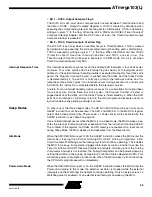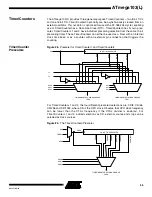
24
ATmega103(L)
0945G–09/01
The most typical program setup for the Reset and Interrupt vector addresses are:
Address Labels
Code
Comments
$0000
jmp
RESET
; Reset Handler
$0002
jmp
EXT_INT0
; IRQ0 Handler
$0004
jmp
EXT_INT1
; IRQ1 Handler
$0006
jmp
EXT_INT2
; IRQ2 Handler
$0008
jmp
EXT_INT3
; IRQ3 Handler
$000A
jmp
EXT_INT4
; IRQ4 Handler
$000C
jmp
EXT_INT5
; IRQ5 Handler
$000E
jmp
EXT_INT6
; IRQ6 Handler
$0010
jmp
EXT_INT7
; IRQ7 Handler
$0012
jmp
TIM2_COMP
; Timer2 Compare Handler
$0014
jmp
TIM2_OVF
; Timer2 Overflow Handler
$0016
jmp
TIM1_CAPT
; Timer1 Capture Handler
$0018
jmp
TIM1_COMPA
; Timer1 CompareA Handler
$001A
jmp
TIM1_COMPB
; Timer1 CompareB Handler
$001C
jmp
TIM1_OVF
; Timer1 Overflow Handler
$001E
jmp
TIM0_COMP
; Timer0 Compare Handler
$0020
jmp
TIM0_OVF
; Timer0 Overflow Handler
$0022
jmp
SPI_STC
; SPI Transfer Complete Handler
$0024
jmp
UART_RXC
; UART RX Complete Handler
$0026
jmp
UART_DRE
; UDR Empty Handler
7
$000C
INT5
External Interrupt Request 5
8
$000E
INT6
External Interrupt Request 6
9
$0010
INT7
External Interrupt Request 7
10
$0012
TIMER2 COMP
Timer/Counter2 Compare Match
11
$0014
TIMER2 OVF
Timer/Counter2 Overflow
12
$0016
TIMER1 CAPT
Timer/Counter1 Capture Event
13
$0018
TIMER1 COMPA
Timer/Counter1 Compare Match A
14
$001A
TIMER1 COMPB
Timer/Counter1 Compare Match B
15
$001C
TIMER1 OVF
Timer/Counter1 Overflow
16
$001E
TIMER0 COMP
Timer/Counter0 Compare Match
17
$0020
TIMER0 OVF
Timer/Counter0 Overflow
18
$0022
SPI, STC
SPI Serial Transfer Complete
19
$0024
UART, RX
UART, Rx Complete
20
$0026
UART, UDRE
UART Data Register Empty
21
$0028
UART, TX
UART, Tx Complete
22
$002A
ADC
ADC Conversion Complete
23
$002C
EE READY
EEPROM Ready
24
$002E
ANALOG COMP
Analog Comparator
Table 4.
Reset and Interrupt Vectors (Continued)
Vector No.
Program
Address
Source
Interrupt Definition
















































